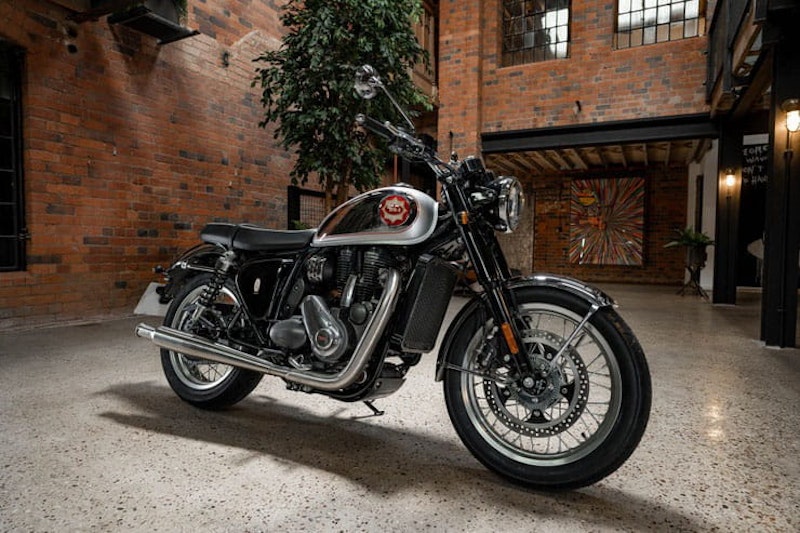What’s next from born again British bike brand BSA?
By Ben Purvis
Motorcycle Journalist
27.04.2023
Whether it’s a long-term trend or a flash-in-the-pan fad there’s a distinct trend towards retro-styled machines evoking the heyday of the British bike industry at the moment – and given the current state of the economy it’s no surprise that it’s skewed towards the more affordable end of the market.
Royal Enfield has long been leading the charge, with a remarkable change in fortunes over the last few years that’s seen it shift from an anachronistic laughing-stock to a major player that’s setting the standard in this emerging class. The Indian-owned brand’s decisions to open a UK R&D centre and embrace larger, twin-cylinder machines while keeping an iron grip on its heritage thanks to masterful product strategy and development from design boss Mark Wells and ex-Triumph man Simon Warburton have been key to its recent success. This year we’ll see Triumph hit back with its own Indian-made machines, built in cooperation with Bajaj, and just months ago another British name, BSA, was revived with the launch of the new 650cc Gold Star single.
Like its main rivals, BSA’s name reeks of the golden era of British motorcycling, but with a strong Indian connection. The brand is owned by Mahindra, one of India’s leading automotive names, and despite a relatively low-key introduction the Gold Star is already something of a hit. With production just getting off the ground, it leapt to the number one spot in the ‘modern classic’ segment of the UK sales chart, with 253 examples registered in March this year alone. For context, that beats the similarly new Royal Enfield Super Meteor 650 (171 sales in March) and only fractionally lags behind the bargain that is Honda’s new CB750 Hornet (271 sales). Of course, BMW’s R1250GS Adventure, despite nearing the end of its days, remains in its now-traditional spot as the overall best-selling big bike (364 registered in March) and Honda’s PCX125 beats them all with 374 sales in the month.
Above: The BSA Gold Star, above, is already proving a success
Like Royal Enfield’s machines and the upcoming Triumph singles, the Gold Star is designed in the UK and manufactured in India, and like its rivals it pulls off the trick of looking convincingly like a classic bike despite using a modern(ish) water-cooled engine – it’s based on the well-established 652cc Rotax design that used to power various BMWs – and features niceties like disc brakes and ABS to make sure the riding experience doesn’t include the unwelcome aspects of genuine old bike ownership. We were impressed with our first ride on the machine, and the sales numbers suggest others feel the same way.
So, what’s next from BSA? With a long history to delve into, the company has already started to make moves towards other models, initially by making moves to snap up the trademark rights on a batch of names to use on additional bikes. The titles ‘Bantam’, ‘Lightning’ and ‘Thunderbolt’ are all subject to trademark applications at the moment across various territories, giving a strong clue as to the next bikes we can expect to wear the BSA badge.
Of them, the Bantam is perhaps the easiest to pin down. In the past, as its name suggests, Bantam was BSA’s name for its lightweight, entry level model. The original was a two-stroke single, made over a huge production run from 1948 to 1971, starting at 125cc and eventually growing to 175cc. Unlike the firm’s four-stroke machines, the Bantam was actually designed in Germany, starting life as a DKW before being reworked as a BSA after WW2. While any future Bantam clearly won’t be a two-stroke, Mahindra’s existing motorcycle division is well placed to create a machine that mirrors the original’s mixed heritage, as it also owns the Jawa brand, using it to make a range of retro-styled bikes around 295cc and 334cc single-cylinder engines. It’s easy to imagine one of these machines becoming the basis of a future BSA Bantam, offering an entry-level machine that would rival Royal Enfield’s 350cc singles and the upcoming 250cc-400cc Triumphs.
The Thunderbolt and Lightning names are also echoes from BSA’s past, although riders under 50 might be more likely to associate both titles with another company, Buell, which sold bikes wearing both those titles in more recent years.
Today, it appears that Buell’s rights over those names have lapsed and BSA is jumping at the chance to get them back.
If the company is to be true to its heritage, the Thunderbolt and Lightning should both be parallel twin models with substantially more capacity and performance than the Gold Star. The original 1960s machines were 650cc twins (the Thunderbolt has a single carb, the Lighting used two for more performance), conforming with the norms of ‘big’ British bikes and acting as in-house rivals to Triumph’s similarly-sized twins of the period. BSA owned Triumph at the time and the final BSA Thunderbolts in 1973 were actually rebadged Triumph TR6s.
That raises a question over the position of future BSA Lightning and Thunderbolt models in the company’s range. One option is to create a 650cc twin, competing with the similar layout used by Royal Enfield in the Meteor 650, Continental GT 650 and Interceptor 650 models. However, BSA’s existing Rotax-based single in the Gold Star is already close to those machines in terms of performance and price, making it a direct competitor despite the different cylinder count. That suggests future Lightning and Thunderbolt models, if they are to be the twins that conform with the names’ histories, could be larger-capacity bikes to compete with Triumph’s 900cc or even 1200cc Bonneville and its derivatives.
Regardless of the route it takes, it’s increasingly clear that Mahindra has big plans for BSA going into the future.
Share on social media:

